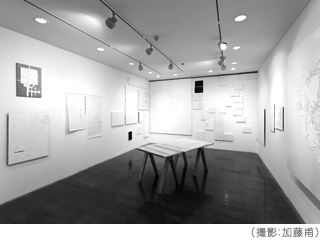@SUNAO HORIKAWA All Rights Reserved.
STATEMENT
堀川すなおの制作の出発点は、「目の前に存在する対象に対して、自明とされる対象の捉え方とは別の捉え方があるのではないか」という疑問である。つまり、日常的に目にする3次元の対象物を2次元の媒体に変換する過程において、写真のように目の前の物事を忠実に記録したかのような対象の捉え方や、遠近法のような広く知れ渡り使用されている対象の捉え方があるが、堀川の制作では、このような対象の捉え方とは異なる手法を模索する。
対象の捉え方の新たな手法を模索するにあたり、堀川は人が対象を認識する過程に着目している。人は日常的に対象を認識する際、過去の経験や知識に基づいて無意識のうちに、その対象が何であるかを判断している。しかし、その判断には時として先入観や固定概念が影響を与えている。そのため、堀川が対象を捉える際には、対象をよく観察することを重視している。そして、人がどのように対象を捉え、認識し、理解しているのか、いくつかの認識の過程を想定し、制作に用いている。例えば、対象を認識する上で必要な対象の形を抽出し、その形を個々の対象だけでなく、対象が属するカテゴリー全体、つまり特定のバナナの形ではなく、「バナナ」という名称をもった物に共通する形に簡略化することで、人が対象を捉える際に対象に付随するイメージで捉えていることを表す制作手法や、人が対象を認識する際に、対象の全体像ではなく、興味を持った部分や印象に残った部分に着目し、その一部分から対象全体を構成していることを、特徴的な部分の拡大や誇張によって表す制作手法である。
このように、堀川の制作では、人がどのように対象を捉えているのかを視覚化することで、対象を画一的ではない新しい視点で捉えることができる表現方法を開拓している。
The starting point of Sunao Horikawa's work is the question, "Isn't there a way of perceiving objects that exist before our eyes that is different from the self-evident way of perceiving them?" In other words, in the process of converting three-dimensional objects seen in daily life into two-dimensional media, there are ways of perceiving objects that seem to faithfully record things in front of us, like photographs, or widely known and used methods like perspective. However, in Horikawa's work, she seeks methods that differ from these conventional ways of perceiving objects.
In exploring new methods of perceiving objects, Horikawa focuses on the process by which people recognize objects. In everyday life, when people recognize objects, they unconsciously judge what those objects are based on past experiences and knowledge. However, these judgments are sometimes influenced by preconceptions and fixed ideas. Therefore, when Horikawa captures objects, she emphasizes careful observation. She then considers several processes of recognition and uses them in her work, imagining how people perceive, recognize, and understand objects. For example, one technique extracts the necessary shapes for recognizing an object and simplifies them not just for individual objects, but for the entire category they belong to - not the shape of a specific banana, but the common shape of things named "banana." This method expresses how people perceive objects through associated images. Another technique focuses on and exaggerates characteristic parts of an object, representing how people construct the whole object from parts that interest them or leave an impression, rather than perceiving the entire image at once.
In this way, Horikawa's work aims to visualize how people perceive objects, encourage questioning of human preconceptions and fixed ideas, and explore new ways of expression that allow objects to be seen from fresh perspectives.


© SUNAO HORIKAWA All Rights Reserved.

